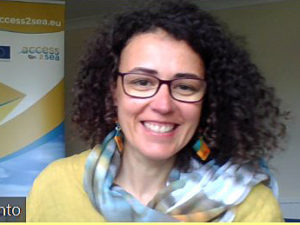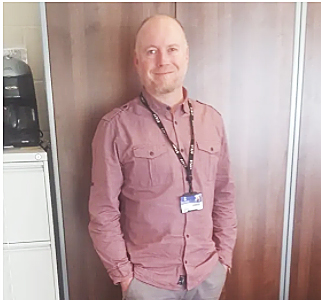Talking sensors

A total of 157 participants from 33 countries attended the webinar on the Application of Sensors in Precision Aquaculture (#aquasensors).
Hosted by Swansea University’s Centre for Sustainable Aquatic Research (CSAR) in collaboration with the Waterford Institute of Technology on 25 of May 2021, the webinar is now available on YouTube and the talks can be downloaded from the website.

Dr Sara Barrento, marine biologist and science communicator at CSAR
Dr Sara Barrento, marine biologist and science communicator at CSAR, introduced the webinar topic and noted the motivation behind the need for precision aquaculture for real-time sensor technology to facilitate sustainable management of aquaculture facilities as they increase in size and become more advanced, locate further offshore and aim towards restorative aquaculture.
Dr Barrento also introduced the Access2Sea project pilot case study on lumpfish welfare. The team at CSAR is developing the Lumpfish Welfare Watcher a web-based application that will calculate the Lumpfish Operational Welfare Score Index (LOWSI) based on four visual indicators (skin damage, eye condition, caudal fin damage and suction disk deformities), and the relative weight. The application will also have a Body Mass Index (BMI) calculator, funded by the Seafood Innovation Fund, the calculator allows to determine the proportion of lumpfish that are emaciated, underweight, and normal, along with recommendations for action.

Professor Carlos Garcia de Leaniz, director of CSAR at Swansea University
Professor Carlos Garcia de Leaniz, director of CSAR at Swansea University, introduced the STREAM (Sensor Technologies for Remote Environmental Aquatic Monitoring) project. The project is monitoring Coastal and Estuarine environments around both Ireland and Wales using cost effective sensors to support the coastal industry (including aquaculture), environmental and climate science.

Dr Sofia Teixeira of the Tyndall Institute in Ireland
Dr Sofia Teixeira of the Tyndall Institute in Ireland presented on smart sensors for wellness and health in aquaculture. These sensors are non-invasive and provide rapid tests to monitor health by measuring indicators, such as cortisol, that have wide applications in the assessment of the immune competence, stress, growth, and behaviour.

Professor David Gethin, of the Welsh Centre for Printing and Coating (WCPC) at Swansea University
Professor David Gethin, of the Welsh Centre for Printing and Coating (WCPC) at Swansea University, gave a brief overview of commercial sensors and highlighted the benefits of printable sensors; they are less expensive and can measure a range of parameters in an integrated system. However, printable sensors need to be calibrated against laboratory and commercial devices, and their durability still needs to be tried and tested. Professor Gethin also provided an overview of the methods used to print the sensors being developed for the STREAM project.

Brian O’Loan, of Bord Iascaigh Mhara
Brian O’Loan, of Bord Iascaigh Mhara gave a very informative presentation on the shellfish aquaculture industry in the SE of Ireland. He began by explaining the value of shellfish aquaculture in the region and the impacts that the Covid-19 pandemic has had on the industry. Mr O’Loan then discussed the commercial sensors he had used in the past outlining the good and bad points of each. Mr O’Loan presented data that he had recorded in the area during previous sampling programmes and projects. Mr O’Loan concluded by reiterating the pressures faced by the Aquaculture industry and the need for more affordable, spatially, and temporally sophisticated real-time monitoring with notifications if a parameter goes outside a pre-defined level.

Paul Shanahan, of the National Maritime College of Ireland (NMCI
Paul Shanahan, of the National Maritime College of Ireland (NMCI), highlighted the advantages that coastal radar systems provide, such as accurate local weather information which can be disseminated to social media and coastal stakeholders who can make choices on whether it is safe/ suitable to carry out an activity/ operation on a given day. Mr Shanahan explained the type of radar in use, its characteristics, locations and showed the data it generates talking the audience through the various characteristics of the radar display. The STREAM project is hoping to deploy one of these radars in Swansea, Wales in the near future.
- Paul Howes, Manager of the Centre for Sustainable Aquatic Research
- Dr Pete Jones, STREAM projects at Swansea University
- Dr Josh Jones, STREAM projects at Swansea University
Paul Howes, Manager of the Centre for Sustainable Aquatic Research, alongside Dr Pete Jones and Dr Josh Jones, researchers working on the STREAM projects at Swansea University, did a talk on the research taking place in CSAR using sensors. Mr Howes focused on the unique facilities and projects taking place in CSAR, using a variety of species from microalgae to fish, and topics such as aquaponics and aqua biotech. Dr Pete Jones focused on experimental lab work using sensors for determining preference and avoidance thresholds for marine organisms. Dr Josh Jones focused on the mapping opportunities and challenges for aquaculture and fisheries, using relevant data from sensors.

Gyopár Elekes of faptic.xyz
Gyopár Elekes, of faptic.xyz, focused on the use of machine vision technology that can access lumpfish clinging behaviour. The technology uses underwater cameras to record stereoscopic images, the AI and deep learning algorithms allow collecting key data which will then inform on the number of fish, define thresholds for fish density and, in the case of lumpfish, access the proportion of fish clinging and swimming.

Christian Berger, of PEBL – Plant Ecology Beyond Land
Christian Berger, of PEBL – Plant Ecology Beyond Land, focused on the importance of monitoring low trophic sea farms: the data can be used to inform on the ideal location of new aquaculture sites, create optimized harvest schedules, provide early warning and troubleshooting and validate sustainable objectives (carbon, nitrogen, biodiversity). He presented the SeaLens: a low-cost sea farm monitoring tool and a case study on a proposed seaweed and shellfish farm in Skye.
The webinar on the Application of Sensors in Precision Aquaculture had the support from the European Project Access2Sea funded by the Interreg Atlantic Area Programme through the European Regional Development Fund and STREAM: Sensor Technologies for Remote Environmental Aquatic Monitoring funded by the European Regional Development Fund through the Ireland Wales Cooperation programme.
Application of Sensors in Precision Aquaculture (#aquasensors). https://www.swansea.ac.uk/bioscience/csar/news/
![]()





